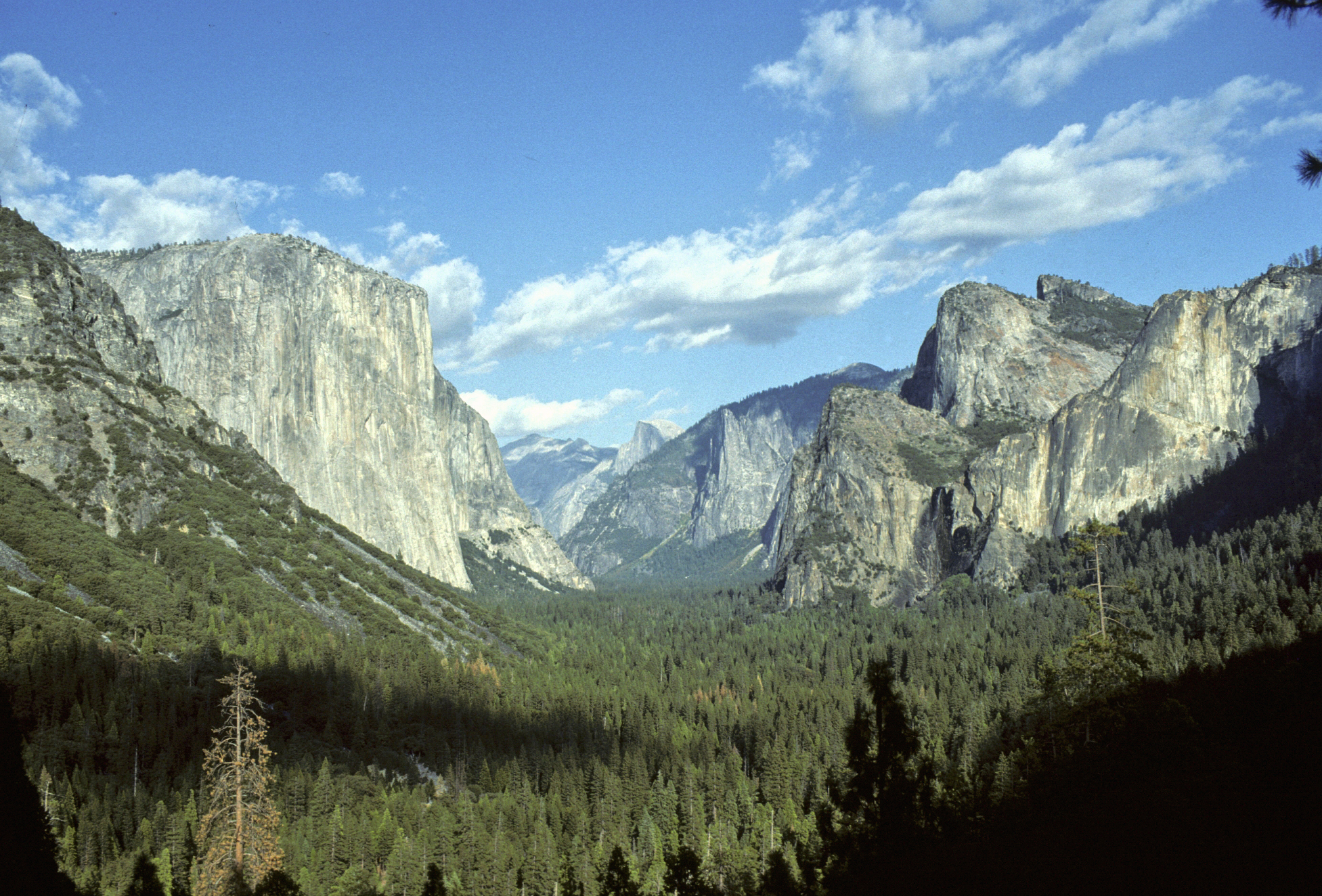Land Use Impacts
Land use impacts result from the coupled social and environmental complex adaptive systems. Most commonly, the strongest impacts are society on nature. Many of these feed into the worsening weather-related crises being experienced around the world as well as oceanic dead zones (excess nitrogen runoff from agricultural fertiliser use), habitat destruction (development of greenfields), and soil degradation (development and agricultural practices). These extremes are indications of the changing climate due to the greenhouse effect as predicted by Eunice Foote (1856), but commonly attributed to John Tyndall (1859)*.

Yosemite Valley, ©Darien Simon
While it is usually considered a rural land use issue, agriculture impacts every settlement everywhere. It provides the food we eat wherever we live. The institutionalisation of agriculture as a primary cultural form – settled instead of wandering communities – has impacted social systems and the environment for approximately 10,000 years. However, it is only recently (meaning the last few hundred years) that the human population has increased to the point where agricultural lands are now in danger from the expanding urban centres, both in terms of their existence (consumed by sprawl), and in the workforce required to ensure successfully grown and harvested crops.
At the same time, there are more and more people, all of whom need housing, education, work, sanitation, food, clothing, transportation, and water. The increasing demand for developable land – housing in urban areas, industry and commerce in both urban and rural areas, and arable land in rural and wilderness areas – contributes directly to the environmental system impacts of these social system requirements in the form of land use impacts.
The urban – rural divide has become so extreme in some places that people in cities no longer understand where their food comes from (“the supermarket” is a common response). Nor is there general understanding of the land use impacts of the industrialisation or corporatisation of agriculture, from destruction of family farms and local economies to monoculture crops to alterations of natural soil and crop cycles by chemical fertilisers (instead of allowing the soil to regenerate naturally) and even genetically engineered seeds (often requiring not only new seed purchases annually, but sometimes also requiring patented fertilisers or other supplements).
There are also numerous environmental impacts from modern farming:
“Research suggests that the world’s soils are now eroding 100 times faster than new soil can form, and an estimated 33 percent of soil is so degraded that its ability to grow crops is compromised. Meanwhile, monoculture — the strategy of sowing huge fields with a single crop — achieves higher yields but also puts more pressure on soil and increases the risk that plants will succumb to pests or disease.
“Many of humanity’s solutions to these problems also create other issues, Land Institute researchers say. Fertilizer can counter soil degradation, but it pollutes waterways and produces nitrous oxide, a potent greenhouse gas. Pesticides might reduce threats from insects, but they destroy other vital species. Cover crops will curb erosion, but they can be difficult to plant and maintain.
“And modern farming is hugely carbon intensive. Factoring in fuel for machinery and food transport, methane produced by belching livestock, and the carbon that’s lost when ecosystems are converted to cropland, agriculture accounts for about a quarter of humanity’s annual planet-warming emissions.
“Yet farms are also threatened by climate change, which will increase the risk of prolonged droughts and catastrophic floods.”**
Any threat to farm production also threatens the ability of society to meet food, fibre, and fuel requirements.
Read more about Complexity Factors
Here’s a start on understanding some of the linkages between the social and environmental complex adaptive systems and land use impacts:
To date, society has expected land and naturally evolved ecosystems to adapt to social demands. To an extent, this has occurred, but nature has limits, and they are being transgressed. The increase in population, coupled with expanding numbers of demands on natural systems, is overwhelming the natural systems ability to adapt. Evidence clearly shows the impacts of human society on nature have become extensive and enduring enough that society will now have to adapt to emerging and unpredictable changing land and ecosystem conditions; globally this is climate change. These novel conditions and changes arise due to nonlinear feedback loops that push the system beyond tipping points.
Standing in the way of success are the path dependencies in place in policy, thought, behaviour, and attitudes, the rapidly accelerating changes over time that minimise the ability of many governments to act due to procedural requirements, entrenched special economic interests, a lack of knowledge about alternate domains of stability, and ignorance of how to best use levers and hubs.
What else can you think of?
System Conditions & Sample Analysis
Navigating the chaotic waters of complex situations requires expanding considerations to engage multiple perspectives, depending on which are the most relevant to the current situation. Whether the issue is agriculture or urban housing, a diverse group of perspectives are required because of the complex interlinkages and land use impacts.
In practice, however, traditionally most (western-style) communities have focused on new development as a source of economic benefits (tax revenues) marginalising social and environmental considerations. Planning practices often apply a “highest and best use” standard for decision making, where the loftiness of the use can loosely correlate to the tax rate imposed. In the process, prime farmland has been transformed into shopping malls or planned communities. One attempt to counter this has been to keep the property taxes lower for active agricultural land to encourage farmers to keep farming. Depending on how it’s structured, the tax system may be more advantageous to corporate rather than family farms, unintentionally marginalising part of the original purpose – to support family farms. This endless growth and sprawl model of land use is a primary cause of several land use, social, and environmental systems challenges.
Another option to address the housing need is refurbishing older housing, transforming formerly commercial or industrial space to residential or mixed uses, or rebuilding within the existing built environment. While this minimises the land use impacts of housing, it can have social impacts via gentrification, in which established communities, often lower income, are replaced over time by incomers with higher incomes.
Alternatives such as urban farms can be multifaceted solutions to interlinked land use challenges locally, while failing to address the impacts of change on the farms and farm workers. These indirect land use impacts can lead to transformational change, positive or negative, depending on the perspective of the evaluator.
Depending on their origins, urban farms may be more or less inclusive and community-building, more or less innovative, more or less emerging and evolving. More traditional kitchen garden/allotment space is purposed to grow food or flowers, replacing or enlarging a house garden. While working on their allotments, people tend to be friendly and cooperative, sometimes collaborative, but a central goal is usually not building community. However, some very innovative urban farms have grown organically to include _______ (reference!)
In addition to providing food, agricultural and horticultural training, and a connection with the Earth often lacking in urban environments, another benefit of urban farms can be adding value and pride in the neighborhood, which can lead to property improvements (making existing housing more attractive market-wise), development of other communal activities, and a sense of cohesion and communality.
These more innovative and inclusive urban farms are more resilient in unpredictably changing times because their core values reflect a willingness to embrace new ideas in order to better address the challenge(s) they face. They are sufficiently open to emergent and self-organising practices that they can overcome path dependency, adapt to nonlinear, unexpected, and indirect effects, and constructively apply levers and hubs to creatively identify a new, sustainable domain of stability. The changes they create can provide the tipping power to move the neighborhood and/or community toward a new, more equitable and sustainable reality.
Some things to consider:
- What are the best projections of the local need for new/additional housing within the next X years?
- What does the existing housing stock consist of?
- How old is it?
- What are the tradeoffs between refurbishing and upgrading it, replacing it (neighborhood renewal), and new construction (brownfields redevelopment or development of greenfields worsening sprawl)?
- What limits are imposed by:
- geography,
- local history and the path of development to date,
- the existing planning and zoning codes,
- the economic and political conditions locally and nationally,
- attitudes toward science and climate change,
and
- How do the options compare in terms of long-term sustainability?
What other questions can you think of?
